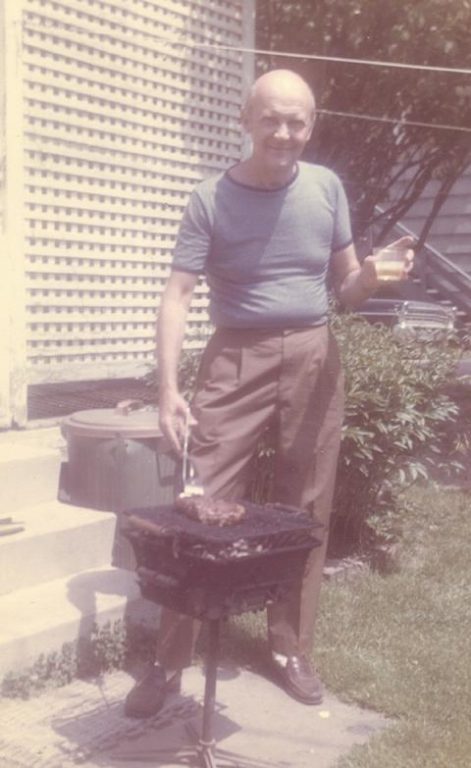There were tremendous bursts of flame when he tossed in his match, or often a lighted cigarette. One epic blast singed his eyebrows and his chest hair, but even in his fifties he could toss the match and back-pedal as swiftly as a quarterback fleeing the blitz. His nuclear experiments at the hibachi made life more exciting for us – my brother called the grill area Los Alamos and stayed away – and for our immediate neighbours in the stone-dead hill town where we lived. Not that the family needed more excitement from Harold Senior, as the professor was known. What’s entirely familiar about this photograph, besides the grill tongs in his right hand, is the drink in his left. It’s whiskey, maybe a Manhattan on this occasion, but martinis were the staple mood elevator for my father and all the male adults – and near-adults – in his extended family. For me, all these years later, a dry martini is still the shortest distance between a malignant universe and a benign one. I allow myself one a week, and always wish I could still drink more.

Only rarely and providentially do the vices of the fathers fail to be visited on the sons. I hesitate to call my father an alcoholic or even a problem drinker, though others might not hesitate. But consider the competition, the norm for his generation. He was approximately the same age as the writer John Cheever, and in the new Cheever biography by Blake Bailey, the whiskey widow Mary Cheever recalls ‘But everyone drank a lot back then. People don’t always understand that now. Sometimes someone would have to be put to bed before dinner, but that’s just the way it was.’ By these standards, and compared with friends’ memories of unconscious fathers laid out in the bar car when the commuter train pulled into Darien, Harold Senior’s consumption was only a notch above average. Unfortunately he had a combustible temper, and alcohol was its fuel of choice. Nuclear charcoal ignitions were not the only explosions his children experienced.
When I look at this photograph now, I see the confidence and charm in that smile – he was amply confident and charming – but I also see the glass in his left hand, I hear the rattle of the ice in his glass, like a bell that could ring welcome or ring danger. ‘Come, sit down and listen,’ the smile says, and God knows no one could talk like the old man, whether it was the Partition of Poland on his mind, or making Prohibition gin in a bathtub. I loved to be included, loved to listen, but it could be nearly fatal not to notice how many times his glass had been refilled. He died in 1983. I miss him very much, but the photograph brings back the ambivalence in our relationship, which was too much like my relationship with the dangerous habit we shared: Drink, relax, spend a moment with me here in this quiet green place – but watch out.
Cover photograph by Kjersti Magnussen







